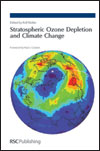Now Published
Stratospheric Ozone Depletion and Climate Change
Edited by Rolf Muller
“Few fields in atmospheric sciences have experienced such a stormy development as atmospheric chemistry. When I first entered the field some forty years ago it was still thought that stratospheric ozone was regulated by four reactions, (after Chapman, 1930) involving only the oxygen allotropes 0, 02 and 03. We now know that a complete stratospheric reaction scheme contains more than a hundred reactions in the gas phase, the liquid phase and on the surface of particulate matter. These reactions involve chemical compounds, which have there orgins in human activities, such as anthropogenic nitrogen and halogen oxides. Together with dynamics and transport, they create a mix of processes which determine the observed distribution of stratospheric ozone.” Paul J. Krutzen
Today, the activities of mankind have a greater effect on the composition of the atmosphere for a number of important trace species than emissions from natural sources; examples include sulphur dioxide and nitric oxides. Furthermore growing fossil-fuel consumption and agricultural activities have caused increases in green-house gases, in particular carbon dioxide, methane and nitrous oxide, leading to climate change on the timescale of decades to millennia.
In this exemplary new book, written by a distinguished team of international researchers, the authors present the scientific basis for understanding stratospheric ozone depletion and its interplay with climate change.











